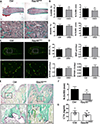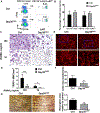Role of chromatin modulator Dpy30 in osteoclast differentiation and function
- PMID: 35307321
- PMCID: PMC9063347
- DOI: 10.1016/j.bone.2022.116379
Role of chromatin modulator Dpy30 in osteoclast differentiation and function
Abstract
Osteoclasts are the principal bone resorption cells crucial for homeostatic bone remodeling and pathological bone destruction. Increasing data demonstrate a vital role of histone methylation in osteoclastogenesis. As an integral core subunit of H3K4 methyltransferases, Dpy30 is notal as a key chromatin regulator for cell growth and differentiation and stem cell fate determination, particularly in the hematopoietic system. However, its role in osteoclastogenesis is currently unknown. Herein, we generated Dpy30F/F; LysM-Cre+/+ mice, which deletes Dpy30 in myeloid cells, to characterize its involvement in osteoclast differentiation and function. Dpy30F/F; LysM-Cre+/+ mice showed increased bone mass, evident by impaired osteoclastogenesis and defective osteoclast activity, but no alteration of osteoblast numbers and bone formation. Additionally, our ex vivo analysis showed that the loss of Dpy30 significantly impedes osteoclast differentiation and suppresses osteoclast-related gene expression. Moreover, Dpy30 deficiency significantly decreased the enrichment of H3K4me3 on the promoter region of NFATc1. Thus, we revealed a novel role for Dpy30 in osteoclastogenesis through epigenetic mechanisms, and that it could potentially be a therapeutic target for bone destruction diseases.
Keywords: Bone resorption; Dpy30; H3K4 methylation; Osteoclast.
Copyright © 2022 Elsevier Inc. All rights reserved.
Conflict of interest statement
Declaration of competing interest
The authors declare no conflicts of interest.
Figures







Similar articles
-
Major vault protein (MVP) negatively regulates osteoclastogenesis via calcineurin-NFATc1 pathway inhibition.Theranostics. 2021 May 24;11(15):7247-7261. doi: 10.7150/thno.58468. eCollection 2021. Theranostics. 2021. PMID: 34158848 Free PMC article.
-
Babam2 negatively regulates osteoclastogenesis by interacting with Hey1 to inhibit Nfatc1 transcription.Int J Biol Sci. 2022 Jul 11;18(11):4482-4496. doi: 10.7150/ijbs.72487. eCollection 2022. Int J Biol Sci. 2022. PMID: 35864959 Free PMC article.
-
Dehydrocostus lactone attenuates osteoclastogenesis and osteoclast-induced bone loss by modulating NF-κB signalling pathway.J Cell Mol Med. 2019 Aug;23(8):5762-5770. doi: 10.1111/jcmm.14492. Epub 2019 Jun 21. J Cell Mol Med. 2019. PMID: 31225720 Free PMC article.
-
Epigenetic and transcriptional regulation of osteoclast differentiation.Bone. 2020 Sep;138:115471. doi: 10.1016/j.bone.2020.115471. Epub 2020 Jun 8. Bone. 2020. PMID: 32526404 Review.
-
Fine-tuning osteoclastogenesis: An insight into the cellular and molecular regulation of osteoclastogenesis.J Cell Physiol. 2023 Jul;238(7):1431-1464. doi: 10.1002/jcp.31036. Epub 2023 May 14. J Cell Physiol. 2023. PMID: 37183350 Review.
Cited by
-
Posttranslational Modification in Bone Homeostasis and Osteoporosis.MedComm (2020). 2025 Apr 1;6(4):e70159. doi: 10.1002/mco2.70159. eCollection 2025 Apr. MedComm (2020). 2025. PMID: 40170748 Free PMC article. Review.
-
Molecular Crosstalk between Chromatin Remodeling and Tumor Microenvironment in Multiple Myeloma.Curr Oncol. 2022 Dec 5;29(12):9535-9549. doi: 10.3390/curroncol29120749. Curr Oncol. 2022. PMID: 36547163 Free PMC article. Review.
References
-
- Boyle WJ, Simonet WS, and Lacey DL (2003) Osteoclast differentiation and activation. Nature 423, 337–342 - PubMed
-
- Novack DV, and Teitelbaum SL (2008) The osteoclast: friend or foe? Annu Rev Pathol 3, 457–484 - PubMed
-
- Teitelbaum SL, and Ross FP (2003) Genetic regulation of osteoclast development and function. Nat Rev Genet 4, 638–649 - PubMed
-
- Takayanagi H, Kim S, Koga T, Nishina H, Isshiki M, Yoshida H, Saiura A, Isobe M, Yokochi T, Inoue J, Wagner EF, Mak TW, Kodama T, and Taniguchi T (2002) Induction and activation of the transcription factor NFATc1 (NFAT2) integrate RANKL signaling in terminal differentiation of osteoclasts. Dev Cell 3, 889–901 - PubMed
-
- Takeshita S, Kaji K, and Kudo A (2000) Identification and characterization of the new osteoclast progenitor with macrophage phenotypes being able to differentiate into mature osteoclasts. J Bone Miner Res 15, 1477–1488 - PubMed
MeSH terms
Substances
Grants and funding
LinkOut - more resources
Full Text Sources
Molecular Biology Databases
Research Materials
Miscellaneous

